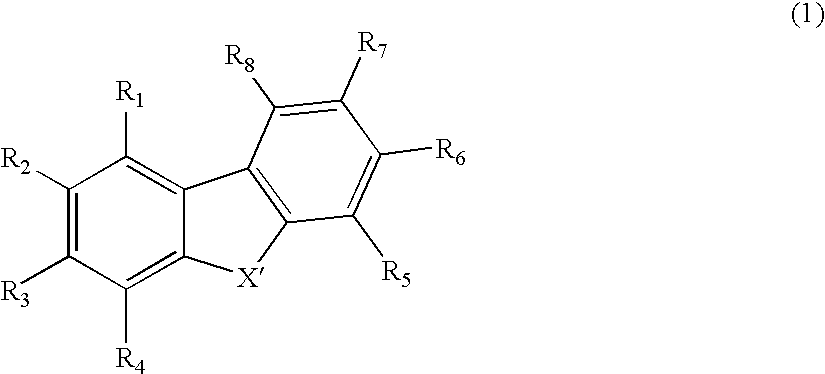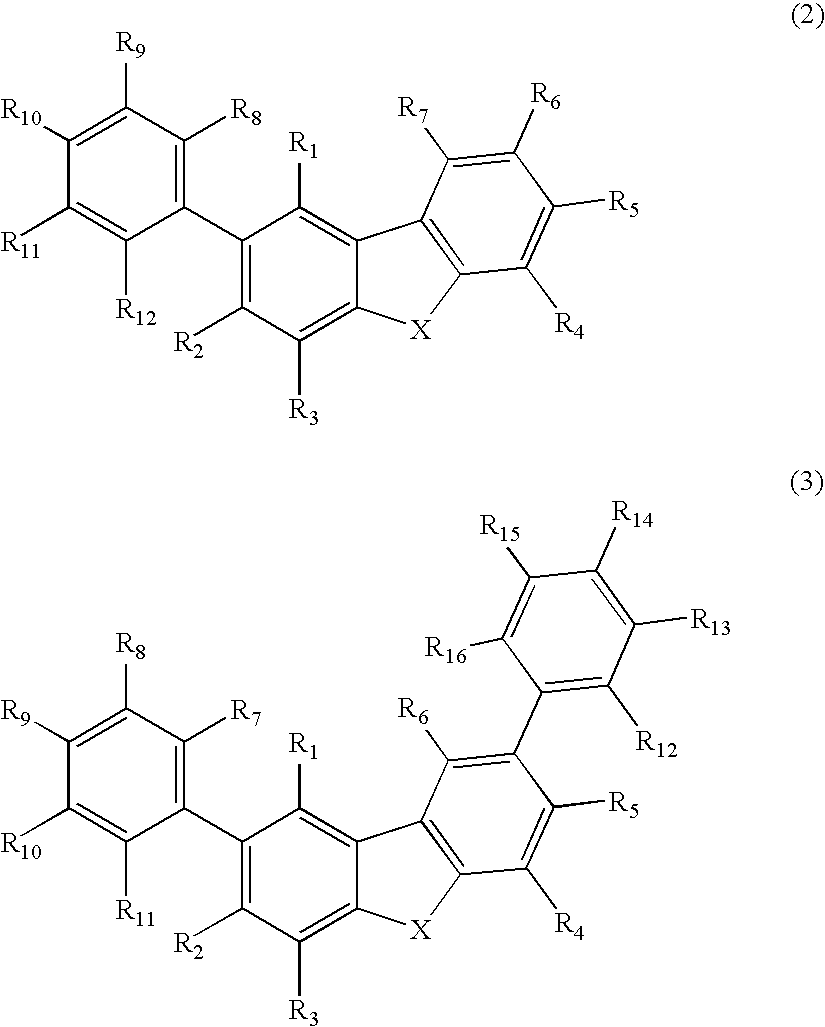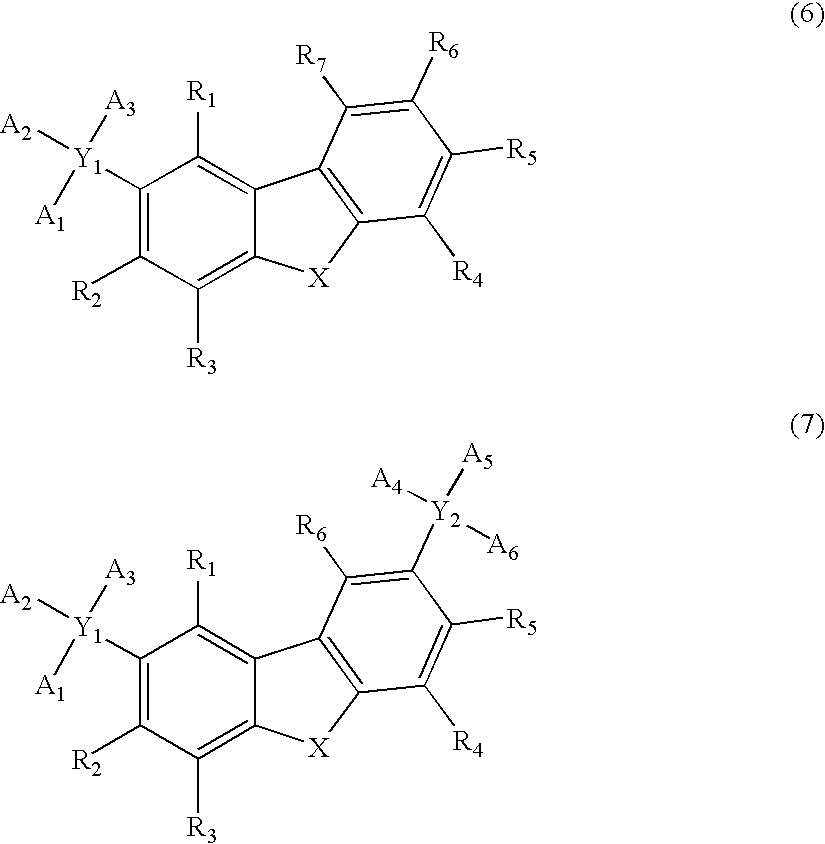Material for organic electroluminescence device and organic electroluminescence device using the same
a technology of electroluminescence device and material, which is applied in the direction of thermoelectric device, discharge tube luminescnet screen, natural mineral layered product, etc., can solve the problems of compound and difficult application to phosphorus luminescent device, and achieve superior heat resistance, prolong the life, and enhance the current efficiency of light emission
- Summary
- Abstract
- Description
- Claims
- Application Information
AI Technical Summary
Benefits of technology
Problems solved by technology
Method used
Image
Examples
synthesis example 1
[0150]The route for synthesis of Compound (B-1) is shown in the following.
[0151]Under the atmosphere of argon gas, 2,8-dibromodibenzothiophene in an amount of 1.31 g (3.83 mmol), boronic acid A in an amount of 2.50 g (9.12 mmol) and tetrakis(triphenylphosphine)palladium in an amount of 0.527 g (0.456 mmol) were placed into a three neck flask with a capacity of 300 milliliter, and the air inside the flask was replaced with argon gas. Adding 1,2-dimethoxyethane in an amount of 27.4 milliliter and 2.0 M sodium carbonate aqueous solution in an amount of 13.7 milliliter (27.4 mmol) into the flask, the resultant solution was refluxed by heating for 9 hours under the atmosphere of argon gas. Water in an amount of 100 milliliter and methylene chloride in an amount of 100 milliliter were added to the resultant reaction solution, and an organic layer was separated, followed by drying with the use of anhydride magnesium sulfide. After concentrating the dried mixture under reduced pressure by m...
synthesis example 2
[0153]The route for synthesis of Compound (A-1) is shown in the following.
[0154]Under the atmosphere of argon gas, 2,8-dibromodibenzofuran in an amount of 2.53 g (7.76 mmol), boronic acid A in an amount of 5.07 g (18.5 mmol) and tetrakis(triphenylphosphine)palladium in an amount of 1.07 g (0.925 mmol) were placed into a three neck flask with a capacity of 300 milliliter, and the air inside the flask was replaced with argon gas. Adding 1,2-dimethoxyethane in an amount of 55.5 milliliter and 2.0 M sodium carbonate aqueous solution in an amount of 27.8 milliliter (55.5 mmol) into the flask, the resultant solution was refluxed by heating for 9 hours under the atmosphere of argon gas. Water in an amount of 100 milliliter and methylene chloride in an amount of 100 milliliter were added to the resultant reaction solution, and an organic layer was separated, followed by drying with the use of anhydride magnesium sulfide. After concentrating the dried mixture under reduced pressure by means ...
synthesis example 3
[0156]The route for synthesis of Compound (B-16) is shown in the following.
[0157]Under the atmosphere of argon gas, 2,8-dibromodibenzothiophene in an amount of 2.15 g (6.29 mmol), boronic acid B in an amount of 2.97 g (15.0 mmol) and tetrakis(triphenylphosphine)palladium in an amount of 0.867 g (0.750 mmol) were placed into a three neck flask with a capacity of 300 milliliter, and the air inside the flask was replaced with argon gas. Adding 1,2-dimethoxyethane in an amount of 45.0 milliliter and 2.0 M sodium carbonate aqueous solution in an amount of 22.5 milliliter (45.0 mmol) into the flask, the resultant solution was refluxed by heating for 10 hours under the atmosphere of argon gas. Water in an amount of 100 milliliter and methylene chloride in an amount of 100 milliliter were added to the resultant reaction solution, and an organic layer was separated, followed by drying with the use of anhydride magnesium sulfide. After concentrating the dried mixture under reduced pressure by...
PUM
| Property | Measurement | Unit |
|---|---|---|
| light emitting wavelength | aaaaa | aaaaa |
| work function | aaaaa | aaaaa |
| thickness | aaaaa | aaaaa |
Abstract
Description
Claims
Application Information
 Login to View More
Login to View More - R&D
- Intellectual Property
- Life Sciences
- Materials
- Tech Scout
- Unparalleled Data Quality
- Higher Quality Content
- 60% Fewer Hallucinations
Browse by: Latest US Patents, China's latest patents, Technical Efficacy Thesaurus, Application Domain, Technology Topic, Popular Technical Reports.
© 2025 PatSnap. All rights reserved.Legal|Privacy policy|Modern Slavery Act Transparency Statement|Sitemap|About US| Contact US: help@patsnap.com



